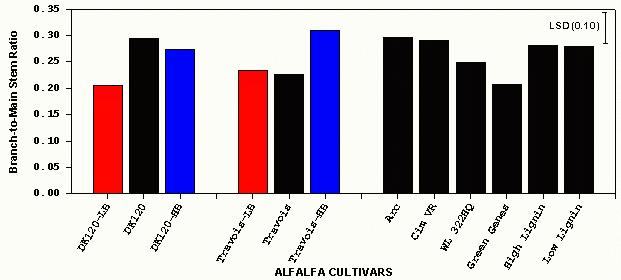Stem Branch Morphology of Alfalfa Cultivars
Kevin D. Kephart, Arvid Boe, Robin Bortnem, and Susan Selman
Plant Science Dept.
South Dakota State University
Brookings, SD 57007
Most attempts to improve alfalfa forage quality have increased leaf-to-stem
ratio (LSR). Yet, increased LSR may not result in improved quality because of
leaf losses. Increased stem quality may be a more stable improvement, but little
is known about difference in stem morphology. The objective of this research is
to determine genetic differences in stem morphology for diverse alfalfa
cultivars. Alfalfa genotypes have been divergently selected for the mass ratio
of branches to main stems (BMR). Six high- and six low-BMR genotypes were
selected from two populations. Half-sib seed was gathered from four divergent
genotypes in 1991.
A single-row nursery was established in 1992. The alfalfa entries included: (i)
progeny of lines selected for high or low BMR from both '120' and 'Travois';
(ii) the cultivars Travois, 120, 'Arc', 'Green Genes', 'WL 322 HQ', 'Cimmaron VR';
and (iii) lines selected for high (HL) or low (LL) herbage lignin concentration.
The experimental design was a randomized complete block with three replicates.
Hand harvest of 1.2 m sections of each plot occurred in June and August 1993 and
June 1994.
Open pollinated progeny from divergent selections for BMR expressed their
phenotypic traits (Fig. 1). High-BMR progeny derived from 120 had 29% higher BMR
than the low-BMR progeny. For divergent progeny derived from Travois, high-BMR
progeny had 35% higher BMR than the low-BMR progeny. Divergent traits were also
expressed in June 1994.

Fig. 1. Branch-to-main stem ratio of 12 alfalfa entries
grown in a solid stand. Values are means over three replicates
and two harvests in 1993.
Divergent progeny did not differ in concentrations of either neutral
detergent fiber (NDF) or acid detergent lignin (ADL) in any of the stem
fractions. Also, divergent progeny did not differ from the cultivar entry from
which they were derived, except that branches of high-BMR progeny derived from
Travois had 16% lower ADL concentration than Travois. There was a positive
relationship between BMR and NDF of main stems (r = 0.83**), but BMR and total
stem NDF were not significantly correlated. There was a positive correlation
between BMR and ADL of branches (r = 0.71). The NDF and ADL concentrations of
total stems were closely related to NDF and ADL of the main stems. Even in high-BMR
progeny, little dilution of the main stem occurred by the presence of branches.
Cell wall composition of the total stem fraction is mostly affected by the
main stem. The proportion and composition of branches in the total stem fraction
had little effect on NDF and ADL concentration of total stems. Concentrations of
NDF in the main stem were positively correlated with BMR.
1995 Central Alfalfa Improvement Conference Proceedings
Send a question or comment directly to the corresponding author:
Dr. Kevin D. Kephart
|